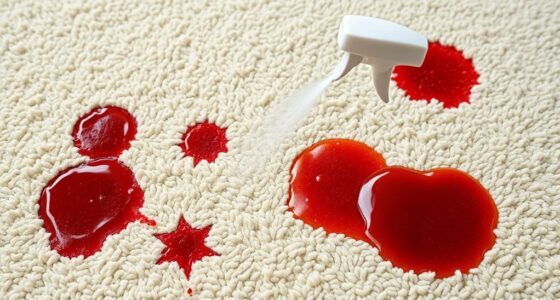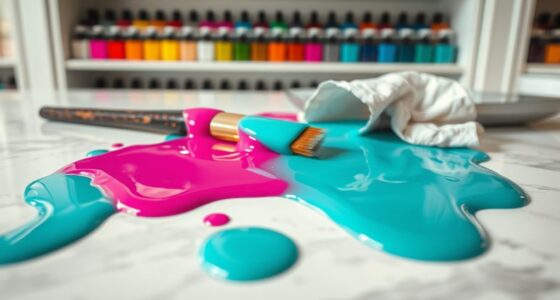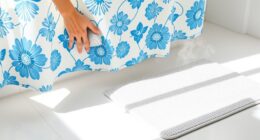To remove water stains from wood furniture, start by applying heat using an iron or hair dryer over a cloth laid on the stain. If that doesn’t work, try oil-based methods—apply mayonnaise or a mix of vinegar and olive oil. For tougher stains, a baking soda paste or fine abrasives can help. Finish by polishing with olive oil or a commercial product for shine and protection. Discover more techniques to keep your furniture looking its best!
Key Takeaways
- Use the iron method by placing a cloth over the stain and applying gentle heat to lift moisture.
- Apply mayonnaise to the stain and let it sit for at least 30 minutes for effective oil-based treatment.
- Create a baking soda paste or use non-gel toothpaste for mild abrasive cleaning of stubborn stains.
- Test mineral spirits or hydrogen peroxide on an inconspicuous area before applying to deeper stains.
- After removal, polish with olive oil or a commercial wood polish for shine and protection.
Understanding Water Stains and Their Causes
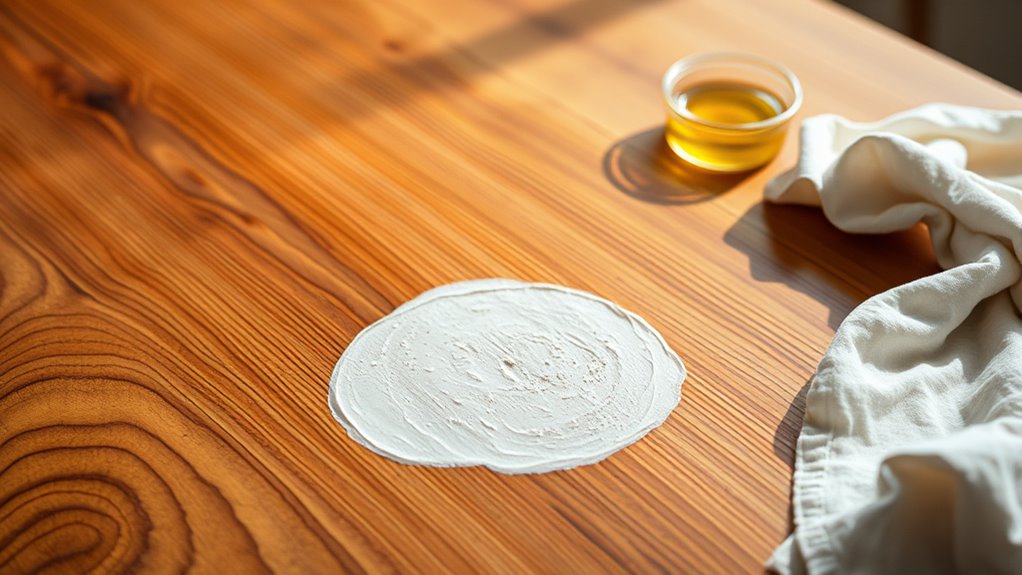
Water stains on wood furniture can be frustrating, especially when you don’t realize how easily they form.
Moisture enters wood surfaces through condensation, spills, or leaks. If you place a cold glass or hot container directly on the wood, you’re likely to create stains. High humidity and temperature changes also contribute to moisture buildup, making softwoods like pine more susceptible than hardwoods like oak. Regular cleaning and polishing are essential for preventing stains and maintaining the longevity of your furniture. In homes with higher humidity, addressing energy consumption through proper ventilation can also help minimize moisture issues. Fading finishes allow moisture to penetrate deeper, increasing the risk of damage. To avoid stains, maintain a consistent indoor climate, and always use coasters under drinks.
Immediate cleanup of spills is essential, along with regular maintenance to preserve your furniture’s protective finish. Understanding these causes helps you keep your furniture looking its best.
Heat-Based Methods for Stain Removal
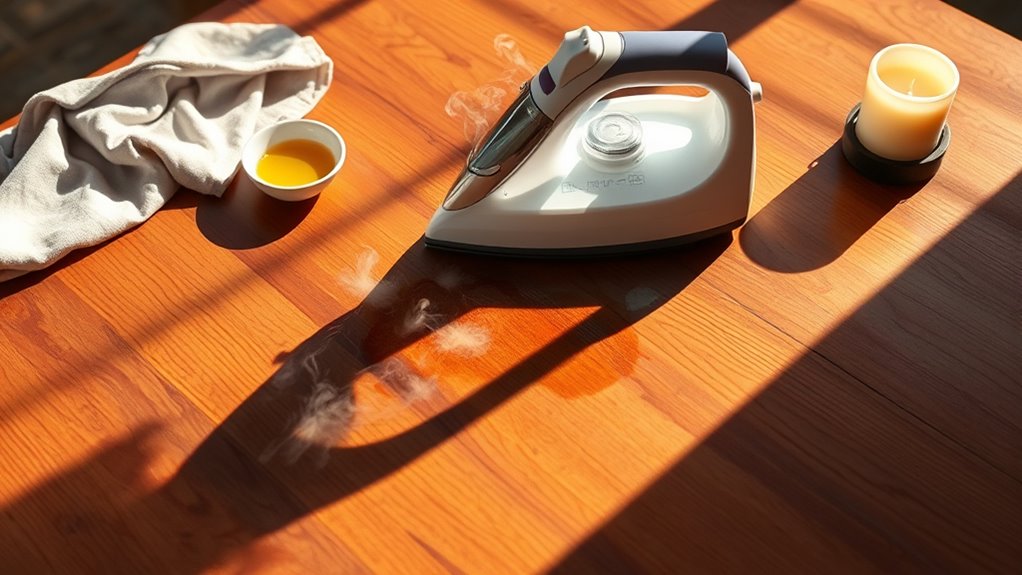
If you’ve got water stains on your wood furniture, heat-based methods can be an effective solution for removing them. One popular technique is the iron method. Just lay a cloth over the stain and apply gentle heat from an iron, ensuring it’s not set to steam. If you don’t have an iron, a hair dryer works too. Always protect your furniture with a cloth to avoid direct heat contact. Before applying heat, clean the surface to remove debris. It’s important to note that different furniture finishes may require varying methods for optimal results. Monitor the process closely to prevent overheating, which can damage the wood.
Oil-Based Techniques to Eliminate Stains

When it comes to tackling water stains on wood furniture, oil-based techniques offer effective solutions that can restore your surfaces. One popular method is the mayonnaise treatment; simply apply it to the stain and let it sit for at least 30 minutes. Gently massage the area before wiping it clean. Additionally, preventive measures such as using coasters can help avoid future stains. Mineral oil is another great choice, as it moisturizes and protects wood—just apply a light coat and buff it the next day. Mixing equal parts vinegar and olive oil can also help; apply it with a soft cloth and follow the grain. For fresh stains, petroleum jelly can fill gaps—leave it on for an hour before wiping. Regular use of avocado or peanut oil can maintain your wood’s health and appearance.
Abrasive Approaches for Stubborn Stains
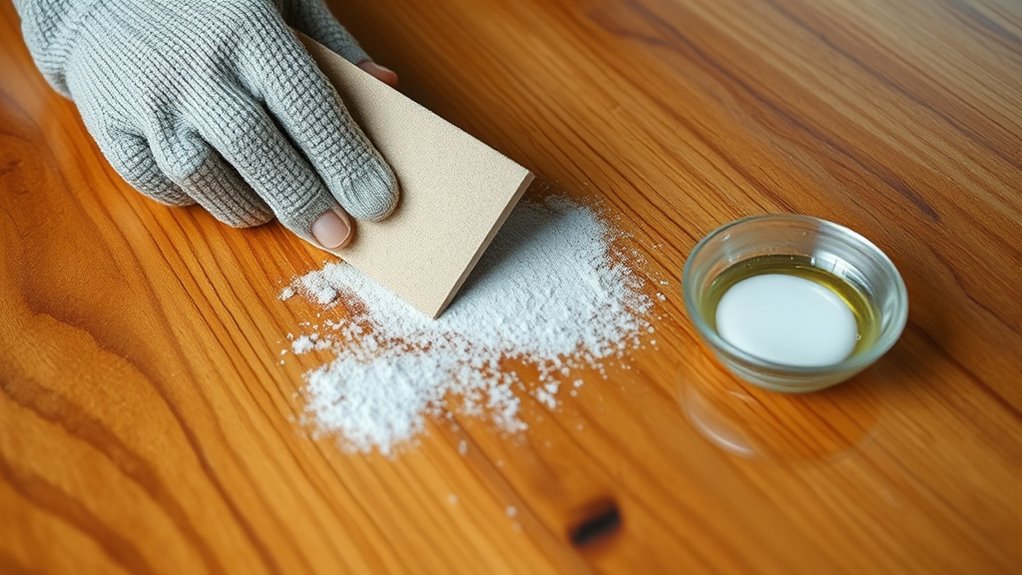
Tackling stubborn stains on wood furniture can be a challenging task, especially since they often penetrate deeper into the surface. For softwoods like pine and cedar, you might need to use more aggressive methods. Start with a mild abrasive like non-gel toothpaste or a baking soda paste, which can help lift the stain. If that doesn’t work, consider fine abrasives like rottenstone mixed with light oil or fine #0000 steel wool, but use it cautiously to avoid scratches. For deeper stains, try applying mineral spirits or hydrogen peroxide, but always test in an inconspicuous area first. Additionally, using baking soda paste can be an effective way to treat persistent stains on wood surfaces.
Polishing and Finishing Touches After Removal
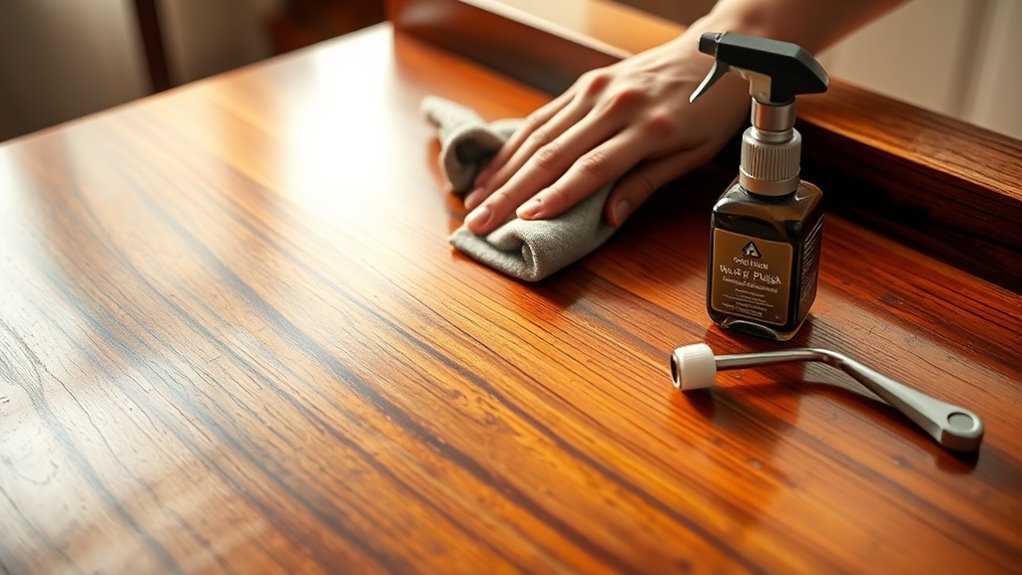
Polishing and finishing touches after stain removal are essential for restoring the beauty of your wood furniture.
Start by applying olive oil lightly in the direction of the grain to bring back shine. Consider using commercial wood polishes designed for furniture—they enhance appearance and offer protection. Using a clean cloth to apply the polish can help ensure an even application without scratching the surface. Use a microfiber cloth to polish, ensuring an even distribution without scratching the surface. Be cautious not to over-polish, as this can create a sticky residue.
Apply olive oil along the grain for shine, or use commercial wood polishes for enhanced appearance and protection.
For added protection against future stains, think about applying a polyurethane or lacquer finish. Regular maintenance, including dusting and polishing, will help keep your wood looking stunning.
Always test new products on hidden areas first to avoid potential damage.
Frequently Asked Questions
Can I Use Vinegar Alone to Remove Water Stains?
You can use vinegar alone to tackle light water stains, but it mightn’t always do the trick, especially for darker stains.
It’s best to mix vinegar with equal parts water for a gentler solution. Always test it on a hidden area first to avoid damaging the wood finish.
If vinegar doesn’t work, consider trying alternatives like baking soda paste or professional help for more stubborn stains.
Will Water Stains Damage the Wood Permanently?
Yes, water stains can cause permanent damage to wood if you don’t address them quickly.
If moisture penetrates beyond the finish, you might notice issues like warping or splitting. Even if the finish appears intact, prolonged exposure can lead to discoloration and structural problems.
To protect your furniture, always act fast when spills occur, and maintain a consistent humidity level to prevent future stains from becoming a more significant issue.
Is It Safe to Use Bleach on Wood Surfaces?
You might think bleach is a quick fix for cleaning wood surfaces, but it can actually do more harm than good.
It breaks down the wood’s structure, leading to damage and discoloration. Plus, it can corrode metal fasteners and harm the environment.
Instead of using bleach, consider safer alternatives like hydrogen peroxide or oxygen bleach, which are gentler and effective without risking the integrity of your wood furniture.
Always prioritize safety and long-term care!
How Often Should I Polish My Wood Furniture?
You should polish your wood furniture every three to six months for general upkeep.
If your furniture sees a lot of action, consider polishing every two to three months.
Keep an eye on environmental factors too—high humidity or dry conditions might warrant more frequent polishing.
Remember, softer woods like pine need polishing more often than hardwoods like oak.
Regular polishing enhances appearance and protects against damage, keeping your furniture looking its best.
Can Sunlight Worsen Water Stains on Furniture?
Isn’t it frustrating when your furniture gets damaged?
Yes, sunlight can worsen water stains on your furniture. The heat from UV rays can make the wood expand, allowing moisture to penetrate deeper, intensifying the stains.
If you’ve got valuable pieces, consider placing them in shaded areas or using protective finishes.
Regular maintenance and mindful placement can help preserve your furniture’s beauty, keeping those pesky stains at bay while enhancing its longevity.
Conclusion
Now that you’ve tackled those pesky water stains, your wood furniture should shine like new. Whether you used heat, oil, or a bit of elbow grease, you’ve taken the bull by the horns and restored your cherished pieces. Don’t forget to polish them up afterward to give them that extra sparkle. With a little care, your furniture will not only look great but also stand the test of time. Keep those stains at bay, and enjoy your beautiful home!


